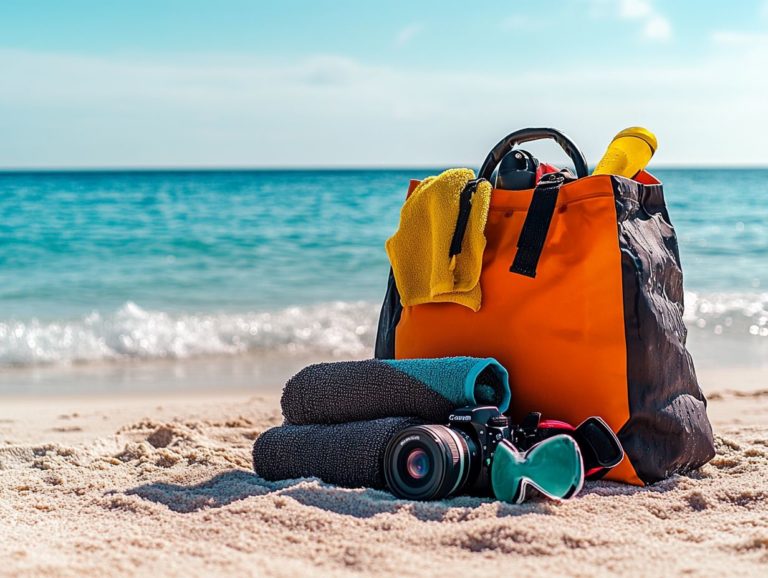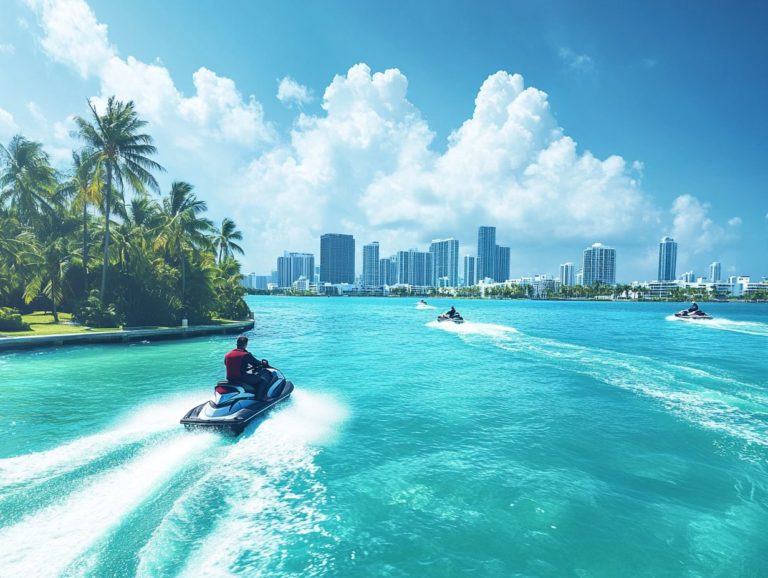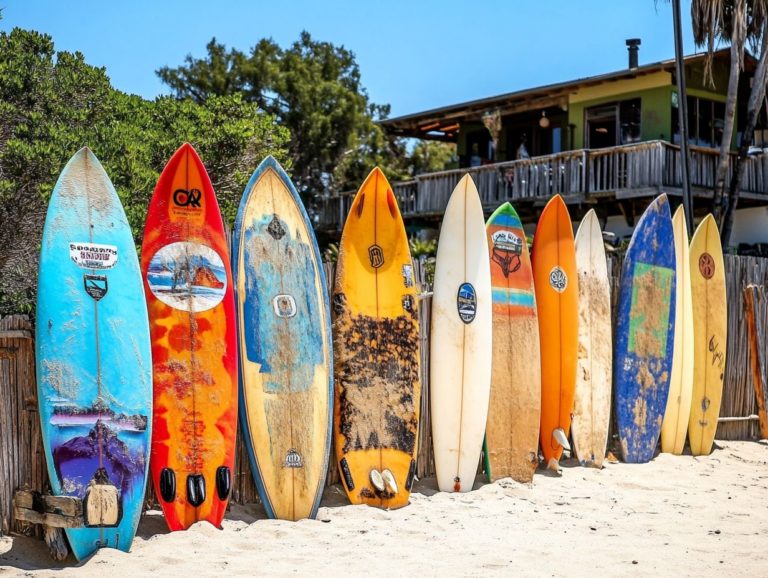How to Choose the Right Fishing Rod
Fishing is a cherished pastime for many, but selecting the ideal fishing rod can feel overwhelming with the multitude of options available.
Whether you’re an experienced fisher or just dipping your toes into the sport, understanding the various types of fishing rods, their components, and the key factors influencing your decision is essential for a successful outing.
This guide will navigate you through the different rod types, encourage you to consider your fishing locations and techniques, and provide practical tips to help you discover the perfect rod for every scenario.
Contents
- Key Takeaways:
- Understanding Fishing Rods
- Factors to Consider When Choosing a Fishing Rod
- Choosing the Right Fishing Rod for Different Situations
- Additional Tips for Choosing the Right Fishing Rod
- Frequently Asked Questions
- What factors should I consider when choosing a fishing rod?
- How do I know what length of fishing rod to choose?
- What is the difference between a fast action and a slow action fishing rod?
- Can I use the same fishing rod for different types of fishing?
- How important is the material of the fishing rod?
- Do I need to test out a fishing rod before purchasing it?
Key Takeaways:
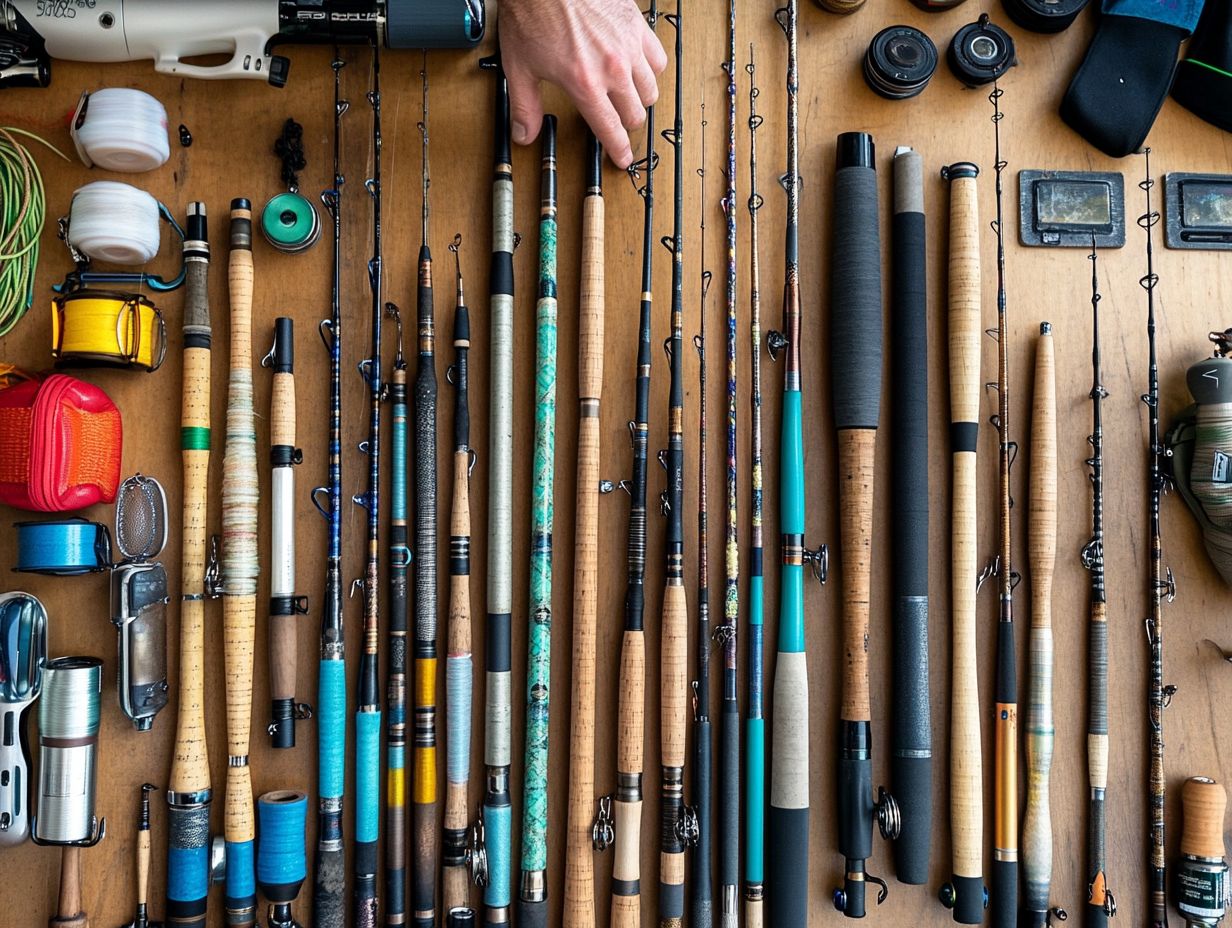
- Consider the type of fishing you will be doing, the location, and the target species to determine the best fishing rod for your needs.
- Different fishing rods are suited for different situations, such as freshwater, saltwater, and fly fishing.
- It s important to consider your budget and personal preferences when selecting a fishing rod, as these factors can greatly impact your overall fishing experience.
Understanding Fishing Rods
Understanding fishing rods is crucial for any fisher eager to enhance their skills and boost their casting distance and technique. With a variety of options available, from spinning rods to casting rods, choosing the right gear can profoundly impact your overall experience on the water.
Considerations such as rod length, power, and sensitivity are key when selecting the best fishing rod tailored to your preferred fishing techniques, whether you’re aiming for Pike, Trout, or Perch.
This guide will also explore the different rod types and empower you to make informed decisions that elevate your fishing game.
Types of Fishing Rods
Fishing rods can be categorized into several types, each tailored to specific fishing styles and preferences. Among these, spinning rods and casting rods are popular due to their distinct features and applications, catering to various fishing methods.
The material of the rod is critical to its performance on the water, influencing factors like casting weight and hook penetration. For example, fiberglass rods are celebrated for their durability and flexibility, making them an excellent choice for beginners or those targeting larger species.
In contrast, graphite rods offer superior sensitivity and lighter weight, enhancing your casting accuracy when fishing for species like trout. Each rod type excels in specific methods; spinning rods are typically favored for light tackle and finesse presentations, while casting rods are ideal for heavier fishing lures and situations requiring more power and control.
Ultimately, selecting the right rod will depend on your preferences, the target species you re pursuing, and the fishing environment you find yourself in.
Components of a Fishing Rod
The components of a fishing rod play a crucial role in its performance and suitability for different fishing techniques. Key elements such as rod length, rod action, and the materials used in the handle are pivotal in determining your casting accuracy, sensitivity, and control.
The rod handle, typically crafted from materials like cork or EVA foam, provides the grip and comfort needed for extended fishing sessions, minimizing fatigue and ensuring better control. Guides are vital for ensuring the smooth passage of your fishing line, directly affecting your casting distance and accuracy.
The reel seat secures the reel firmly; a solid connection here is essential for transferring vibrations and detecting bites. This enhances your hookset capacity. Collectively, these elements contribute not only to the rod s performance but also to your overall fishing success.
Factors to Consider When Choosing a Fishing Rod
Selecting the ideal fishing rod requires careful thought about several key factors. These factors can greatly influence your success on the water.
Consider aspects such as your fishing location, the target species, and the specific fishing techniques you plan to use.
The rod’s specifications like length and action ratings are crucial for your fishing experience. Different setups suit various fishing situations and personal preferences.
Fishing Location
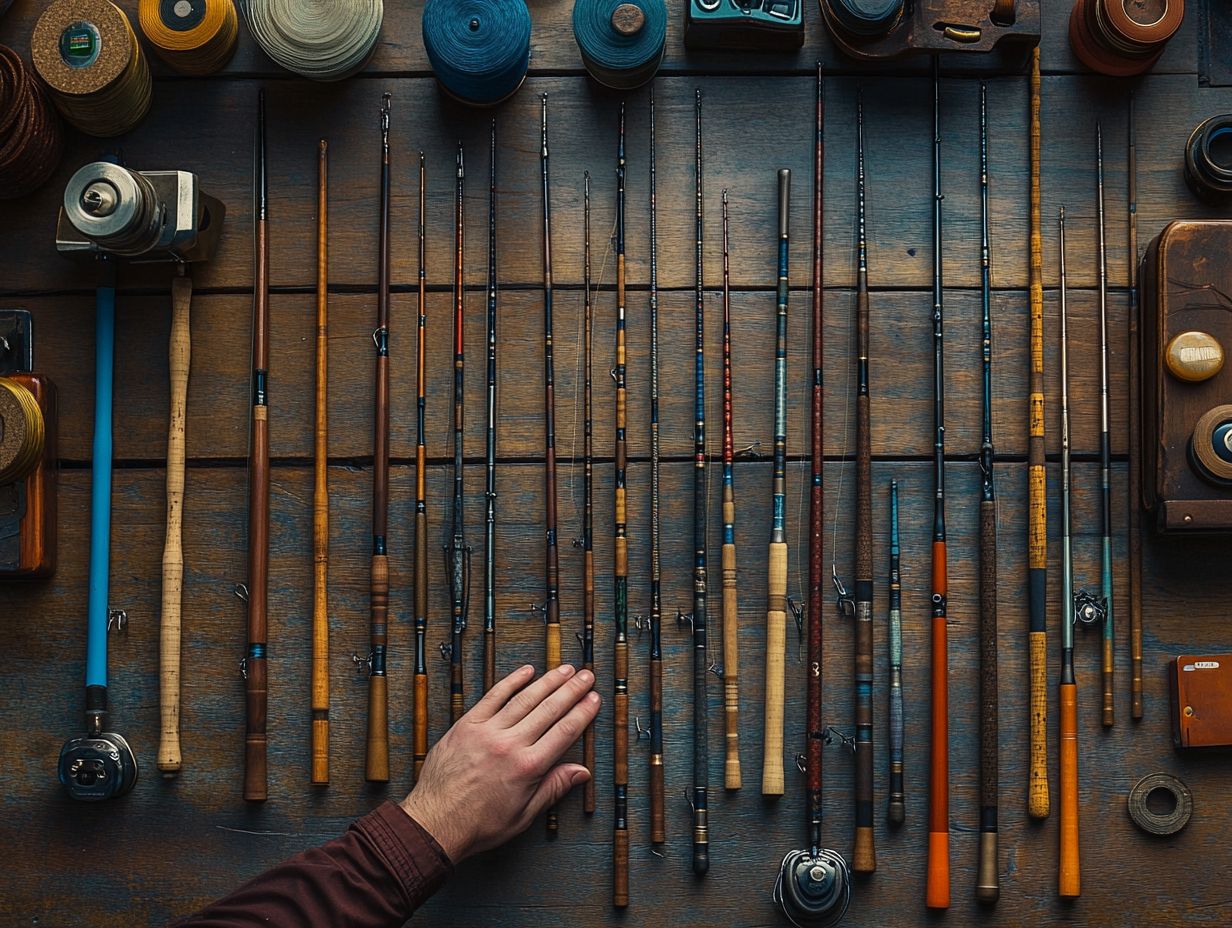
Your fishing location greatly impacts the type of fishing rod to choose. Freshwater and saltwater fishing come with different considerations.
Choose rods based on your location to boost your chances of catching specific fish. For rivers, shorter rods allow for better control and casting accuracy.
In larger lakes, longer rods cover greater distances and manage hook penetration effectively. Ocean fishing typically requires more robust rods to handle larger fish.
Environmental factors like wind and water depth add complexity. Adapt your techniques, from bait selection to casting methods, for optimal success.
Target Species
Identifying your target species is crucial when selecting a fishing rod. Different fish require specific rod characteristics.
For larger species like Zander, a medium-power rod with fast action is ideal. This helps with hook penetration and control, enhancing your experience.
Each species, such as Pike and Perch, needs unique rod specifications. For Pike, use a heavier rod to handle their aggressive strikes.
Perch prefer lighter, sensitive rods for delicate presentations, which improve your accuracy. For Trout, a medium-light rod provides the finesse needed for precise casts.
Matching the rod’s power and action to your target species maximizes performance. This can significantly boost your success on the water.
Fishing Technique
The fishing technique you choose significantly impacts the ideal fishing rod for your needs. Different methods demand specific rod actions and fishing characteristics. Whether you re trolling, casting, or fly fishing, each technique has unique requirements that influence your rod selection.
This includes flexibility ratings and the types of fishing combos and lures you intend to use. Understanding these nuances will elevate your fishing control and accuracy, ensuring your gear aligns with your fishing style.
For example, when you’re trolling for larger species, a heavy-action rod with substantial strength is crucial to manage the strain effectively while utilizing appropriate fishing techniques. On the other hand, when casting lighter lures, you ll want a more flexible medium-action rod that enhances sensitivity and overall fishing performance.
Fly fishing, with its emphasis on precision and delicacy, requires specialized rods tailored for the lighter lines and fishing lures involved. Each of these setups underscores the necessity of aligning rod action with your targeted technique and lure type, ensuring a seamless and productive fishing experience.
Seasoned anglers know that selecting the right rod can be a game-changer when it comes to landing that coveted catch.
Choosing the Right Fishing Rod for Different Situations
Finding the perfect fishing rod can transform your day on the water. It requires a strong understanding of the specific needs inherent to various fishing situations and environments. Whether you’re venturing into freshwater fishing, navigating the waves of saltwater fishing, or mastering the art of fly fishing, each situation offers distinct challenges and opportunities that inform your gear selection.
By opting for the appropriate rod, you can significantly elevate your fishing experience, enhancing both your effectiveness and enjoyment. This ultimately leads to more rewarding outcomes on the water with the right fishing gear.
Freshwater Fishing
Freshwater fishing is an engaging pursuit that demands careful consideration when selecting the right fishing rod to enhance your success and improve your fishing accuracy. The species you re targeting, such as Trout or Perch, will greatly influence your choice regarding rod power, length, and flexibility ratings.
By tailoring your gear for freshwater conditions, you can markedly enhance your casting accuracy and overall fishing experience. Pay special attention to fishing setups that work best in those environments.
An ideal freshwater fishing rod typically falls between 6 to 7 feet in length, striking a perfect balance between casting distance and control. You ll often find that a medium-light to medium power is preferred, offering the sensitivity required to detect those subtle bites while still packing the strength to reel in larger fish.
Opting for a fast action rod can boost your responsiveness, making techniques like baitcasting or jigging easier to execute especially effective for species such as Bass and Crappie.
By ensuring your rod aligns with your specific fishing style, whether you’re floating a bobber or working a crankbait, you significantly increase your chances of landing that successful catch. Don t miss out on that big catch! The right gear can make all the difference.
Saltwater Fishing
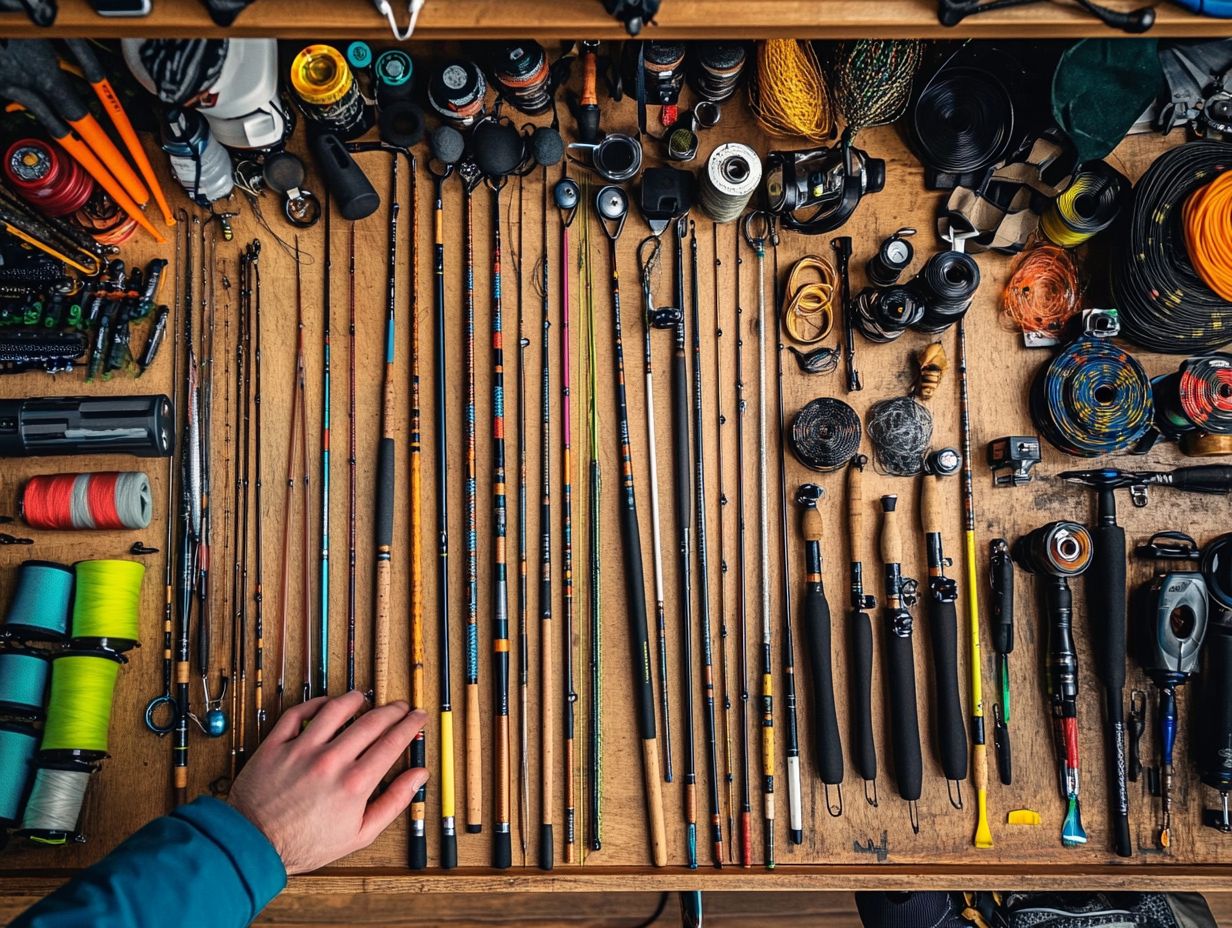
Saltwater fishing brings unique challenges, demanding thoughtful attention to fishing rod selection for optimal performance. You need to consider factors like rod materials, power, and action ratings when targeting species such as Pike or Zander (a type of fish commonly found in Europe).
Choosing the right gear specifically designed for saltwater situations will enhance your control and capabilities while out on the water.
The harsh conditions of saltwater can damage your equipment. It is vital to select rods made from corrosion-resistant materials like fiberglass or graphite.
The rod’s action how flexible it is during casting plays a critical role in determining sensitivity and hook-setting efficiency, which is crucial for your success.
By understanding various fishing techniques from trolling and jigging to casting you’ll be better equipped to determine the ideal rod length and power. This ensures that your gear complements your fishing style and effectively targets the species you re after.
Fly Fishing
Fly fishing is an art that demands a keen eye for detail, particularly when selecting the right rod. Choose a lightweight rod that matches your fishing style for successful casting and lure presentation. Mastering these nuances is essential for any angler looking to elevate their fly fishing skills and make informed gear choices.
Pay close attention to both the length and action of the rod, as these elements shape your overall fishing experience. Longer rods grant you a wider casting reach, making them perfect for larger bodies of water. Shorter rods excel in providing greater control in tighter spots.
The action of the rod, whether slow or fast, influences how it bends during casting. Fast-action rods enhance responsiveness and sensitivity, crucial when targeting species that require precision. Pairing the right rod with suitable lures boosts your chances of success and aligns your techniques with the fish s behavior.
Additional Tips for Choosing the Right Fishing Rod
Picking the perfect fishing rod is exciting, and it goes beyond just grabbing one from the shelf. Additional tips can refine your options and guide you toward an informed decision that resonates with your personal preferences and budget.
- Consider rod materials
- Assess power ratings
- Understand action how flexible the rod is
These factors should complement your fishing techniques and align with your financial parameters, ensuring a rewarding angler experience.
Striking the right balance between quality and cost is essential for enhancing your fishing setups.
Budget Considerations
When choosing a fishing rod, keep your budget in mind to get the best experience on the water! Prices can vary dramatically based on materials, brand, and specifications.
Know your limits to find quality gear that won t break the bank. Typically, fishing rods start at around $30 for budget-friendly options, perfect for beginners, and can soar to over $300 for high-end models favored by seasoned anglers.
The pricier rods are often made from advanced materials like graphite or high-modulus carbon fiber, delivering enhanced sensitivity and durability.
To snag the best value, consider your specific fishing style whether it’s freshwater or saltwater and match that with the right rod action and length. Taking time to read user reviews and compare features online will help you select a rod that fits your budget and aligns with your personal preferences, ensuring satisfaction on the water.
Personal Preference
Personal preference is vital when choosing your fishing rod. Your experiences and style significantly influence your choices.
Factors like rod materials, brand preferences, and fishing techniques impact your comfort and effectiveness.
Understand your preferences to optimize your fishing experience. This enhances your enjoyment on the water.
Consider the weight, length, and action of the rod. These elements greatly affect your ability to cast and feel the catch.
For some, the aesthetics of a rod its color, finish, and brand logo deepen the connection with their gear.
Testing different rods before purchasing is crucial. Finding one that feels perfect in your hands boosts your techniques and enjoyment.
Ultimately, blending personal comfort with functionality makes every fishing adventure more fulfilling.
Frequently Asked Questions
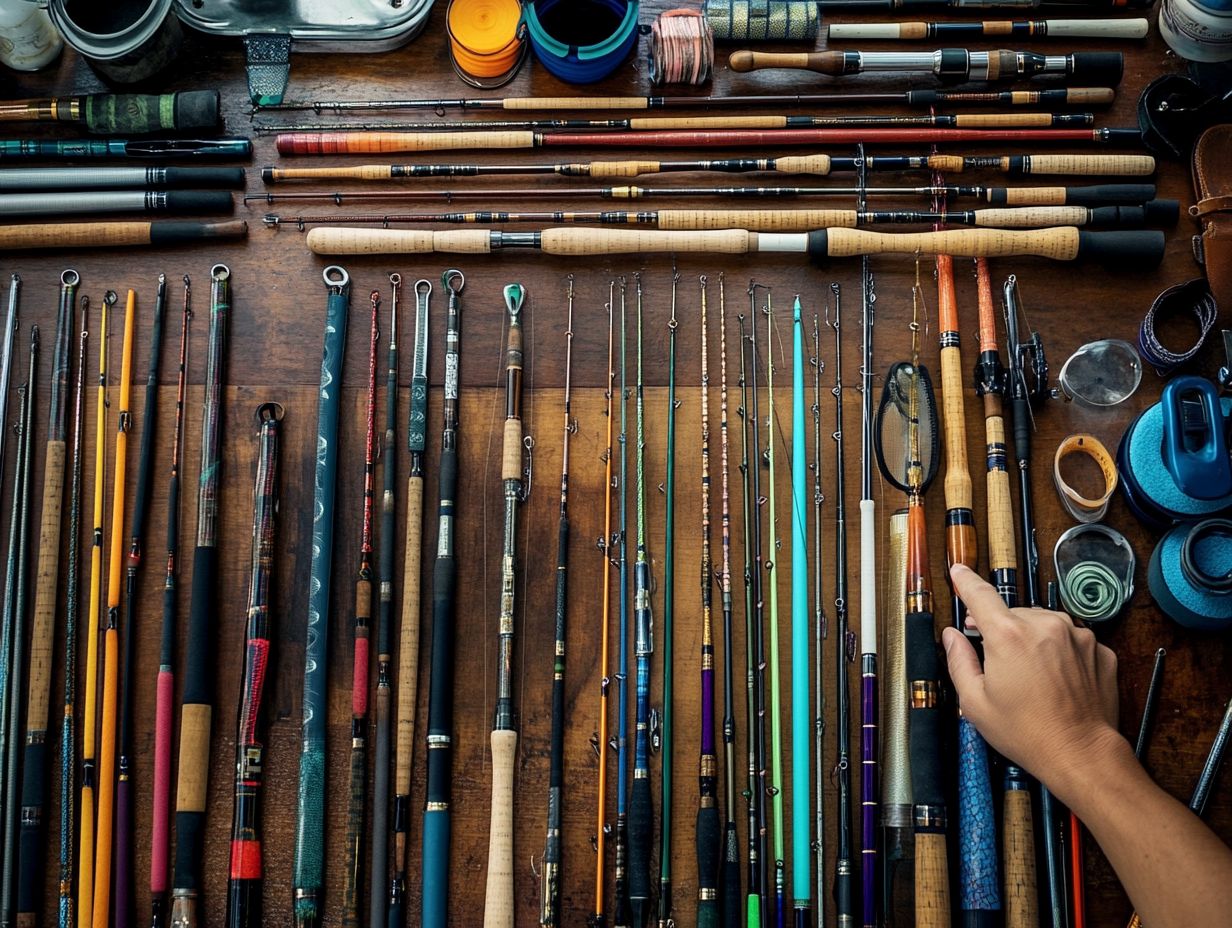
What factors should I consider when choosing a fishing rod?
Consider the type of fish you re targeting and the water conditions. Also, think about your casting style, rod length, power, and action.
How do I know what length of fishing rod to choose?
Your fishing rod length depends on the fishing type. Shorter rods work well in tight spaces, while longer rods are best for long casts.
What is the difference between a fast action and a slow action fishing rod?
A fast action rod bends mostly at the top, ideal for quick hook setting. A slow action rod bends along its length, perfect for smaller fish and tight spots.
Can I use the same fishing rod for different types of fishing?
You can use one rod for different fishing types, but it s not always optimal. Various fishing styles call for different rod lengths, powers, and actions.
How important is the material of the fishing rod?
The material affects performance. Fiberglass rods are durable and affordable; graphite rods are lightweight and sensitive.
Do I need to test out a fishing rod before purchasing it?
Always test a fishing rod before buying. This ensures it feels right for your style. Many stores offer demo rods for this purpose.


